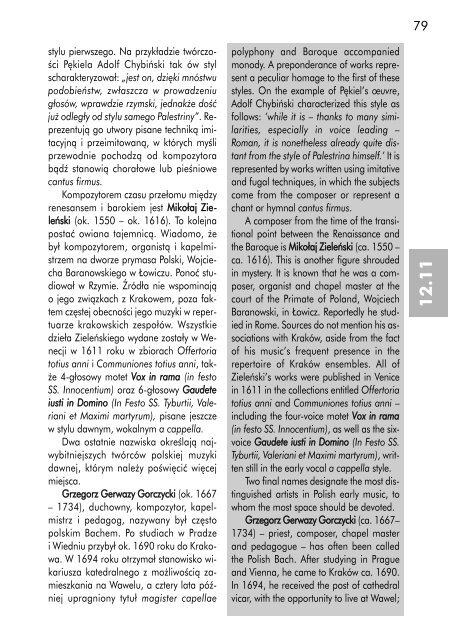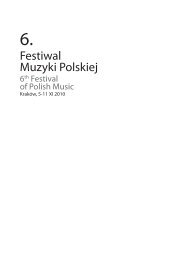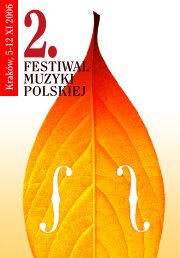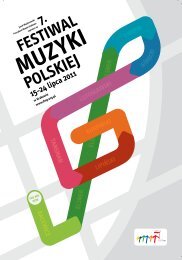Create successful ePaper yourself
Turn your PDF publications into a flip-book with our unique Google optimized e-Paper software.
stylu pierwszego. Na przykładzie twórczości<br />
Pękiela Adolf Chybiński tak ów styl<br />
scharakteryzował: „jest on, dzięki mnóstwu<br />
podobieństw, zwłaszcza w prowadzeniu<br />
głosów, wprawdzie rzymski, jednakże dość<br />
już odległy od stylu samego Palestriny”. Reprezentują<br />
go utwory pisane techniką imitacyjną<br />
i przeimitowaną, w których myśli<br />
przewodnie pochodzą od kompozytora<br />
bądź stanowią chorałowe lub pieśniowe<br />
cantus firmus.<br />
Kompozytorem czasu przełomu między<br />
renesansem i barokiem jest Mikołaj Zieleński<br />
(ok. 1550 – ok. 1616). To kolejna<br />
postać owiana tajemnicą. Wiadomo, że<br />
był kompozytorem, organistą i kapelmistrzem<br />
na dworze prymasa Polski, Wojciecha<br />
Baranowskiego w Łowiczu. Ponoć studiował<br />
w Rzymie. Źródła nie wspominają<br />
o jego związkach z Krakowem, poza faktem<br />
częstej obecności jego muzyki w repertuarze<br />
krakowskich zespołów. Wszystkie<br />
dzieła Zieleńskiego wydane zostały w Wenecji<br />
w 1611 roku w zbiorach Offertoria<br />
totius anni i Communiones totius anni, także<br />
4-głosowy motet Vox in rama (in festo<br />
SS. Innocentium) oraz 6-głosowy Gaudete<br />
iusti in Domino (In Festo SS. Tyburtii, Valeriani<br />
et Maximi martyrum), pisane jeszcze<br />
w stylu dawnym, wokalnym a cappella.<br />
Dwa ostatnie nazwiska określają najwybitniejszych<br />
twórców polskiej muzyki<br />
dawnej, którym należy poświęcić więcej<br />
miejsca.<br />
Grzegorz Gerwazy Gorczycki (ok. 1667<br />
– 1734), duchowny, kompozytor, kapelmistrz<br />
i pedagog, nazywany był często<br />
polskim Bachem. Po studiach w Pradze<br />
i Wiedniu przybył ok. 1690 roku do Krakowa.<br />
W 1694 roku otrzymał stanowisko wikariusza<br />
katedralnego z możliwością zamieszkania<br />
na Wawelu, a cztery lata później<br />
upragniony tytuł magister capellae<br />
polyphony and Baroque accompanied<br />
monody. A preponderance of works represent<br />
a peculiar homage to the first of these<br />
styles. On the example of Pękiel’s oeuvre,<br />
Adolf Chybiński characterized this style as<br />
follows: ‘while it is – thanks to many similarities,<br />
especially in voice leading –<br />
Roman, it is nonetheless already quite distant<br />
from the style of Palestrina himself.’ It is<br />
represented by works written using imitative<br />
and fugal techniques, in which the subjects<br />
come from the composer or represent a<br />
chant or hymnal cantus firmus.<br />
A composer from the time of the transitional<br />
point between the Renaissance and<br />
the Baroque is Mikołaj Zieleński (ca. 1550 –<br />
ca. 1616). This is another figure shrouded<br />
in mystery. It is known that he was a composer,<br />
organist and chapel master at the<br />
court of the Primate of Poland, Wojciech<br />
Baranowski, in Łowicz. Reportedly he studied<br />
in Rome. Sources do not mention his associations<br />
with Kraków, aside from the fact<br />
of his music’s frequent presence in the<br />
repertoire of Kraków ensembles. All of<br />
Zieleński’s works were published in Venice<br />
in 1611 in the collections entitled Offertoria<br />
totius anni and Communiones totius anni –<br />
including the four-voice motet Vox in rama<br />
(in festo SS. Innocentium), as well as the sixvoice<br />
Gaudete iusti in Domino (In Festo SS.<br />
Tyburtii, Valeriani et Maximi martyrum), written<br />
still in the early vocal a cappella style.<br />
Two final names designate the most distinguished<br />
artists in Polish early music, to<br />
whom the most space should be devoted.<br />
Grzegorz Gerwazy Gorczycki (ca. 1667–<br />
1734) – priest, composer, chapel master<br />
and pedagogue – has often been called<br />
the Polish Bach. After studying in Prague<br />
and Vienna, he came to Kraków ca. 1690.<br />
In 1694, he received the post of cathedral<br />
vicar, with the opportunity to live at Wawel;<br />
79<br />
12.11







